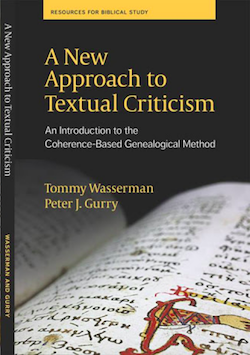
A New Approach to Textual Criticism: An Introduction to the Coherence-Based Genealogical Method, by Tommy Wasserman and Peter J. Gurry. SBL Press & Deutsche Bibel Gesellschaft. Paperback, 146 pages, list price $19.95. Reviewed by Pastor Christian McShaffrey.
Most ministers have not read a book about New Testament textual criticism since their first year of seminary and most church members have probably never read a book on the subject. That might need to change.
Since the dawn of lower criticism in the eighteenth century, the NT text has been changing. The hope of the critics has been to restore it to its “initial” state.
Several “canons” (i.e., rules) were established by the first architects of this textual restoration project, but with the development of computer technology, a new approach to evaluating textual witnesses has been developed: The Coherence-Based Genealogical Method [CBGM].
In short, the CBGM is a computer-assisted model that enables text critics to observe and assess relationships between variant readings on a scale previously not possible. The authors are honest about the limitations of the new model (pp. 56-57, 91-93, etc.), but the overall spirit of the new school seems to be one of optimism.
Due to the subject matter, some pages may need to be read twice; but the authors kept most of the language lucid, appended a thorough glossary, organized the brief chapters quite well, included dozens of diagrams, and cited several examples from the NT to demonstrate how the new method actually works.
“New,” by the way, is a relative term because the CBGM has been in use for over fifteen years now and has already influenced readings in the Nestle-Aland 28th edition [NA28].
No textual changes have yet appeared in English versions that would alarm most readers, but it is really only a matter time. One example is 2 Peter 3:10. The authors cite it early in the book and admit that it will eventually affect translations and “possibly even theology and preaching” [pp. 6, 74-78].
In that verse, a positive eschatological statement is made: “the earth also and the works that are therein shall be burned up” [KJV]. Due to a variant in the final verb, modern versions read, “will be laid bare” [NIV] or “will be exposed” [ESV].
A new reading has been adopted and already appears in NA28 that reverses the meaning. The negative particle ‘ouk’ (i.e., ‘not’) is inserted before the last verb; resulting in the reading, “the earth and the works that are done on it will NOT be exposed.”
Why so significant a change? Was an ancient manuscript recently discovered that revealed this long-lost reading? No, the reading actually has no Greek manuscript support at all and only scant versional support, but the CBGM has helped the editors conclude that it was most likely the initial reading.
Members of the Orthodox Presbyterian Church love the scriptures and should therefore begin preparing themselves for the changes that will be appearing in modern translations.
At very least, our ministers should begin studying this new model so they can, first of all, realize how many of their old assumptions are now out-of-date (e.g. the traditional text-types, the limited value of Byzantine manuscripts, etc.), and, secondly, be prepared to answer the questions that will undoubtedly arise when editorial decisions influenced by the CBGM begin to appear in our pew Bibles.
This book will help immeasurably and while the reviewer does not agree with the authors’ optimistic conclusions about the CBGM, he heartily thanks them for writing this book.
